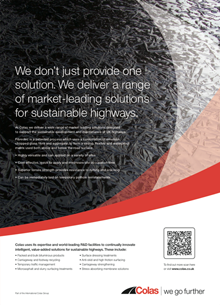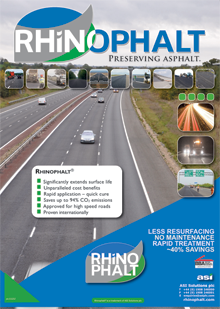eNews
Issue 8 - Winter 2012
RSTA News
ROAD REPAIR AND MAINTENANCE TAKE BEST PRACTICE LEAP
Best practice for road repair and maintenance has taken a significant leap forward thanks to the publication of a suite of Codes of Practice that offer technical and practical guidance based on industry expertise and experience. The Codes aim to deliver the ‘get-it-right-first-time’ approach advocated by the recent HMEP Review.The Codes, developed and published by the Roads Surface Treatments Association (RSTA) and endorsed by ADEPT, were formally launched at a well attended industry seminar held in October in Chester. They fully acknowledge the change of highway delivery through outsourcing and the reduction of local authority in-house expertise that has resulted in a greater reliance on the expertise of the specialist road surface treatment contractor. In this respect, the new codes aim to share that expertise and experience to the benefit of all those involved in road maintenance.
The Codes cover a wide range of road surface treatments including: surface dressing; high friction surfacing; slurry surfacing; re-texturing; geosynthetics and steel meshes; velocity patching; thermal road repairs; recycling; crack and joint repair systems; preservation. This library of technical guidance and best practice is a prime example of the private and public sector working together to share knowledge and expertise. The Codes will improve client technical knowledge and understanding and provide benchmarks of quality and performance for contractors.
Each of the Codes provides a full explanation of the particular road surface process and a useful checklist. They provide the answers to how, what and why for a wide range of road surfacing techniques. In order to ensure their relevance, the Codes will be subject to regular peer review.
The RSTA Codes of Practice may be downloaded from www.rsta-uk.org/publications
ROADS MAINTENANCE SECTOR WELCOMES CALLS FOR NEW FUNDING APPROACH
The Road Surface Treatments Association (RSTA) has welcomed the new report from the CBI that calls for a gear change in investment, performance and efficiency to ensure a road network for the 21st Century. In particular, the report calls for new thinking on how to improve the current inadequate funding for the maintenance and improvement of the UK road network. The shortfall in road repair and maintenance budgets prove that the current funding structures must be overhauled. With public spending checked, there is a compelling need for new funding solutions.The report, ‘Bold Thinking: A model to fund our future roads’, proposes the introduction of a Regulatory Asset Base (RAB) model to secure the private investment necessary to overcome the current funding gaps for the UK’s road network. A £10bnn shortfall in funding for Highways Agency projects and the prospect of declining motoring tax revenue due to the ever-increasing efficiencies of new vehicles makes the current model unsustainable. A regulated model for the road network would address the problem of long-term funding and one year cycles by taking the road network out of the Government’s budget. Road users would have a proportion of their motoring taxes converted to a user charge in order to access to the strategic road network. This charge would provide a funding system for the licensed private operators operating regional sectors of the road network.
Similar models have successfully been applied in other sectors and could open up major private sector investment over the long-term – the water industry alone has generated £98bn of private investment since the 1980s with capped charges on customers.
Part of the new model would see a new governance structure for the UK road network, including the establishment of an independent road regulator, to raise the performance standards of roads and provide greater cost efficiencies. Private operators would manage regional sections of the road network. Strictly enforced performance and maintenance standards and a price cap would help to ensure an affordable, quality road network.
COUNCILS FACE £15 MILLION DAMAGED VEHICLE COMPENSATION CLAIM
Failure to properly maintain roads is costing councils dear. Since 2012, 143 local authorities have between them paid out £4.8 million in compensation claims for vehicle damage caused by neglected roads and potholes. The findings come from research carried out by Britannia Rescue who issued Freedom of Information requests to 424 city, district and county councils. Had all the councils responded the compensation bill is calculated to reach some £15 million.According to Britannia Rescue, 54,436 claims have been made against councils over the last two years for damage to vehicles ranging from ruined wheel rims, damaged suspension and punctured tyres.
The combination of severe winters followed by a wet summer has damaged many parts of the road network. This damage is exacerbated by the severe under-funding of road maintenance. Britannia Rescue calculates that only £17 per driver is spent on maintaining road surfaces and fixing pot holes. This is despite the DVLA road tax amounting to an annual £5.7 billion. Of this only 11% is invested in road maintenance and fixing pot holes.
The high level of compensation claims underlines the futility of under-investment in road maintenance. Local authority budgets are already hard pressed with year-on-year funding cutbacks. It is a Catch 22 situation for them as they cannot afford compensation claims nor do they have adequate budgets for the correct level of maintenance.
AGGREGATE SHORTAGE WARNING UNDERLINE BENEFITS OF ROAD MAINTENANCE
Warnings of future shortages of aggregates for highway construction underline the sustainability benefits of modern road maintenance techniques that extend the service life of roads without the need for structural reconstruction without the need for new aggregates.The warnings come from the Mineral Products Association (MPA) who report that too few new quarries are obtaining planning permission. This means that quarried raw materials need to travel further to road projects thereby increasing transportation costs and carbon emissions. MPA is calling for a more streamlined and responsive planning system. However, there is a range of road surface treatments that do not require newly quarried raw materials. They maintain or recycle the existing road materials on site to significantly prolong the service life of a road without the need for structural reconstruction and, therefore, without the environmental impact of depleting further the availability of natural resources.
One such treatment is mechanical re-texturing to restore skidding resistance and so extend the service life a road without reconstruction. Infrared road repair is another useful treatment that provides a right, first-time reinstatement that reduces the need for new materials by up to 90 per cent. By repairing only the defect without the need to dig-out the pot hole, velocity patching offers another sustainable treatment that has minimum wastage.
At the end of a road’s service life road recycling can use the existing road as a linear quarry. The existing road materials are recycled into a structural sound pavement structure thereby conserving natural resources and significantly reducing the need for imported new material. This technique involves deep layer recycling so in effect the full road length can be treated and recycled. Or, alternatively the process can be used to stabilise a foundation layer as part of new works prior to overlaying with sub-base and bound layers.
Maximising the efficient use of resources is a cornerstone requirement of sustainability and it is one that surface treatments are fully able to meet. The Highways Agency estimates that between 20,000 to 60,000 tonnes of aggregates are used to construct one mile of motorway. Ensuring the long-life of motorways is therefore a sustainable must-do. The use of asphalt preservation techniques such as sprayed stabilising solutions can significantly extend the serviceable life of a road surface and postpone the need for reconstruction.
Many road surface treatments provide a real sustainable alternative to structural maintenance and reconstruction. They extend the service life of roads and reduce the need for new raw materials. And, they don’t need planning permission.
PREDICTIONS OF COLD WINTER ARE BAD NEWS FOR ROADS
Forecasters have warned that the UK could be facing one of its coldest winters for over a decade. This is bad news for those highway authorities who have failed to properly maintain their road networks and for the motorists who use them.The Met Office has briefed the Government and road chiefs to prepare for a colder than average winter. A severe winter will have a detrimental impact upon our roads and could result in a record number of potholes, particularly where local authority highway departments have not carried out proper road maintenance programmes.
Budget constraints mean that many highway authorities are unable to carry out planned, comprehensive maintenance and are forced to adopt an expensive patch-and-mend approach. This approach defies economic logic. It costs only £2 m2 to surface dress and maintain a road but costs on average £78 m2 to repair potholes. Expensive, emergency patch and mend repair of potholes is not a sensible use of highway budgets.
In 2011, the Government’s response to the cost of repairing winter damaged roads was to provide an additional £200 million emergency funding to local authorities. Although welcomed this level of funding, given the £9 billion required to bring the local road network up to a reasonable standard of repair, is inadequate.
Our local road network is an essential national asset which is being undermined and neglected by the lack of adequate funding. Local authorities must be given the resources to enable them to plan and invest in long-term road maintenance.
back to contents »
Copyright 2012 Road Surface Treatments Association. www.rsta-uk.org






